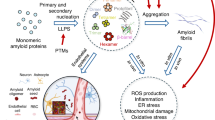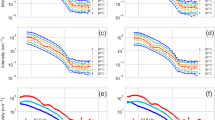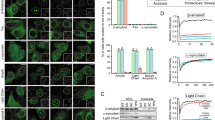Abstract
The formation of amyloid deposits in human tissues is a defining feature of more than 50 medical disorders, including Alzheimer’s disease. Strong genetic and histological evidence links these conditions to the process of protein aggregation, yet it has remained challenging to identify a definitive connection between aggregation and pathogenicity. Using time-resolved fluorescence microscopy of individual synthetic vesicles, we show for the Aβ42 peptide implicated in Alzheimer’s disease that the disruption of lipid bilayers correlates linearly with the time course of the levels of transient oligomers generated through secondary nucleation. These findings indicate a specific role of oligomers generated through the catalytic action of fibrillar species during the protein aggregation process in driving deleterious biological function and establish a direct causative connection between amyloid formation and its pathological effects.
This is a preview of subscription content, access via your institution
Access options
Access Nature and 54 other Nature Portfolio journals
Get Nature+, our best-value online-access subscription
$32.99 / 30 days
cancel any time
Subscribe to this journal
Receive 12 print issues and online access
$259.00 per year
only $21.58 per issue
Buy this article
- Purchase on SpringerLink
- Instant access to full article PDF
Prices may be subject to local taxes which are calculated during checkout




Similar content being viewed by others
Data availability
The authors confirm that all data generated and analyzed during this study are included in this published article and its Supplementary Information. Source data are provided with this paper.
Code availability
All simulation and data analysis codes are included in this article and its Supplementary Information. Codes are available from the corresponding authors on request.
References
Dobson, C. M. Protein folding and misfolding. Nature 426, 884–890 (2003).
Haass, C. & Selkoe, D. J. Soluble protein oligomers in neurodegeneration: lessons from the Alzheimer’s amyloid beta-peptide. Nat. Rev. Mol. Cell Biol. 8, 101–112 (2007).
De Strooper, B. & Karran, E. The cellular phase of Alzheimer’s disease. Cell 164, 603–615 (2016).
Knowles, T. P. J., Vendruscolo, M. & Dobson, C. M. The amyloid state and its association with protein misfolding diseases. Nat. Rev. Mol. Cell Biol. 15, 384–396 (2014).
Chiti, F. & Dobson, C. M. Protein misfolding, functional amyloid, and human disease: a summary of progress over the last decade. Annu. Rev. Biochem. 86, 27 (2017).
Campioni, S. et al. A causative link between the structure of aberrant protein oligomers and their toxicity. Nat. Chem. Biol. 6, 140–147 (2010).
Cremades, N. et al. Direct observation of the interconversion of normal and toxic forms of α-synuclein. Cell 149, 1048–1059 (2012).
Jucker, M. & Walker, L. C. Self-propagation of pathogenic protein aggregates in neurodegenerative diseases. Nature 501, 45–51 (2013).
Jaunmuktane, Z. et al. Evidence for human transmission of amyloid-β pathology and cerebral amyloid angiopathy. Nature 525, 247–250 (2015).
Fusco, G. et al. Structural basis of membrane disruption and cellular toxicity by α-synuclein oligomers. Science 358, 1440–1443 (2017).
Fitzpatrick, A. W. P. et al. Cryo-EM structures of tau filaments from Alzheimer’s disease. Nature 547, 185–190 (2017).
Qiang, W., Yau, W.-M., Lu, J.-X., Collinge, J. & Tycko, R. Structural variation in amyloid-β fibrils from Alzheimer’s disease clinical subtypes. Nature 541, 217–221 (2017).
Peng, C. et al. Cellular milieu imparts distinct pathological α-synuclein strains in α-synucleinopathies. Nature 557, 558–563 (2018).
Spillantini, M. G. et al. α-synuclein in lewy bodies. Nature 388, 839–840 (1997).
Knowles, T. P. J. et al. An analytical solution to the kinetics of breakable filament assembly. Science 326, 1533–1537 (2009).
Michaels, T. C. T. et al. Chemical kinetics for bridging molecular mechanisms and macroscopic measurements of amyloid fibril formation. Annu. Rev. Phys. Chem. 69, 273–298 (2018).
Cohen, S. I. A. et al. Proliferation of amyloid-β42 aggregates occurs through a secondary nucleation mechanism. Proc. Natl Acad. Sci. USA 110, 9758–9763 (2013).
Törnquist, M. et al. Secondary nucleation in amyloid formation. Chem. Comm. 54, 8667–8684 (2018).
Stefani, M. & Dobson, C. M. Protein aggregation and aggregate toxicity: new insights into protein folding, misfolding diseases and biological evolution. J. Mol. Med. 81, 678–699 (2003).
Demuro, A. et al. Calcium dysregulation and membrane disruption as a ubiquitous neurotoxic mechanism of soluble amyloid oligomers. J. Biol. Chem. 280, 17294–17300 (2005).
Bode, D. C., Freeley, M., Nield, J., Palma, M. & Viles, J. H. Amyloid-β oligomers have a profound detergent-like effect on lipid membrane bilayers, imaged by atomic force and electron microscopy. J. Biol. Chem. 294, 7566–7572 (2019).
Panza, F., Lozupone, M., Loogroscino & Imbimbo, B. P. A critical appraisal of amyloid-β-targeting therapies for Alzheimer disease. Nat. Rev. Neurol. 15, 73–88 (2019).
Linse, S. et al. Kinetic fingerprint of antibody therapies predicts outcomes of Alzheimer clinical trials. Preprint at bioRxiv https://doi.org/10.1101/815308 (2019).
Sevigny, J. et al. The antibody aducanumab reduces Aβ plaques in Alzheimer’s disease. Nature 537, 50–56 (2016).
Walsh, D. M. et al. A facile method for expression and purification of the Alzheimer’s disease-associated amyloid β-peptide. FEBS J. 276, 1266–1281 (2009).
Flagmeier, P. et al. Ultrasensitive measurement of Ca2+ influx into lipid vesicles induced by protein aggregates. Angew. Chem. Int. Ed. 56, 7750–7754 (2017).
Michaels, T. C. T. et al. Dynamics of oligomer populations formed during the aggregation of Alzheimer’s Aβ42 peptide. Nat. Chem. 12, 445–451 (2020).
Hellstrand, E., Boland, B., Walsh, D. M. & Linse, S. Amyloid β-protein aggregation produces highly reproducible kinetic data and occurs by a two-phase process. ACS Chem. Neurosci. 1, 13–18 (2010).
Sandberg, M. K., Al-Doujaily, H., Sharps, B., Clarke, A. R. & Collinge, J. Prion propagation and toxicity in vivo occur in two distinct mechanistic phases. Nature 470, 540–542 (2011).
Cohen, S. I. A. et al. A molecular chaperone breaks the catalytic cycle that generates toxic Aβ oligomers. Nat. Struct. Mol. Biol. 22, 207–213 (2015).
Mansson, C. et al. Interaction of the molecular chaperone DNAJB6 with growing amyloid-beta 42 (Aβ42) aggregates leads to sub-stoichiometric inhibition of amyloid formation. J. Biol. Chem. 289, 31066–31076 (2014).
Dunning, C. J. et al. Direct high affinity interaction between Aβ42 and GSK3α stimulates hyperphosphorylation of tau. A new molecular link in Alzheimer’s disease? ACS Chem. Neurosci. 7, 161–170 (2016).
Sowade, R. F. & Jahn, T. R. Seed-induced acceleration of amyloid-β mediated neurotoxicity in vivo. Nat. Commun. 8, 512 (2017).
Eisele, Y. S. et al. Peripherally applied Aβ-containing inoculates induce cerebral β-amyloidosis. Science 330, 980–982 (2010).
Habchi, J. et al. Systematic development of small molecules to inhibit specific microscopic steps of Aβ42 aggregation in Alzheimer’s disease. Proc. Natl Acad. Sci. USA 114, E200–E208 (2017).
Willander, H. et al. High-resolution structure of a BRICHOS domain and its implications for anti-amyloid chaperone activity on lung surfactant protein C. Proc. Natl Acad. Sci. USA 109, 2325–2329 (2012).
Blennow, A., Surin, B. P., Ehring, H., Mc Lennan, N. F. & Spangfort, M. D. Isolation and biochemical characterization of highly purified Escherichia coli molecular chaperone Cpn60 (GroEL) by affinity chromatography and urea-induced monomerization. Biochim. Biophys. Acta 1252, 69–78 (1995).
Acknowledgements
This study has been supported by the Boehringer Ingelheim Fonds (P.F.), the German National Merit Foundation (P.F.), a Marie-Curie Individual Fellowship (S.D.), Peterhouse, Cambridge (T.C.T.M.), the Swiss National Science Foundation (T.C.T.M.), the Wellcome Trust (T.P.J.K., C.M.D., M.V.), the Swedish Research Council (S.L.), the Royal Society (D.K.), the Frances and Augustus Newman Foundation (T.P.J.K.), the Biotechnology and Biological Sciences Research Council (T.P.J.K.) and the Cambridge Centre for Misfolding Diseases (P.F., T.P.J.K., M.V. and C.M.D.).
Author information
Authors and Affiliations
Contributions
P.F. and S.D. performed the experiments. T.C.T.M. developed the theoretical model and performed the kinetic analysis. P.F., S.D., T.C.T.M., X.Y., A.J.D., C.E., M.V., S.L., D.K., T.P.J.K. and C.M.D. participated in designing the study, interpreting the results and writing the paper. P.F., S.D. and T.C.T.M. contributed equally to this work.
Corresponding authors
Ethics declarations
Competing interests
The authors declare no competing interests.
Additional information
Peer review information Inês Chen was the primary editor on this article and managed its editorial process and peer review in collaboration with the rest of the editorial team.
Publisher’s note Springer Nature remains neutral with regard to jurisdictional claims in published maps and institutional affiliations.
Extended data
Extended Data Fig. 1 Reproducible aggregation kinetics of recombinant Aβ42.
a, Monomeric Aβ42 is incubated in the presence of 20 μM ThT under quiescent conditions at 37 °C (red: 2 μM, orange: 2.5 μM, light green: 3 μM, dark green: 3.5 μM, light blue: 4 μM, dark blue: 4.5 μM, black: 5 μM). b, Global fit to the kinetic traces of the Aβ42 aggregation to Supplementary Note 1, Eq. 2, yielding the parameters of Supplementary Table 1. c, Half-times of the aggregation reaction. d, Drawing of the microscopic events of Aβ42 aggregation. Monomeric protein forms small aggregates (for example oligomers) during primary nucleation and these convert into fibrils and their fibril mass growths via elongation. An autocatalytic process, namely secondary nucleation, that depends on both the monomer and fibril concentration leads to an amplification of the aggregation reaction.
Extended Data Fig. 2 Oligomer concentrations are dominated by secondary oligomers.
Fraction of primary oligomers (over total oligomer population) calculated using the fitting parameters of Fig. 1c of the main text.
Extended Data Fig. 3 The addition of seed fibrils accelerates the aggregation of Aβ42.
a, Monomeric Aβ42 was incubated at a concentration of 2 μM in the presence of 20 μM ThT at 37 °C under quiescent conditions in the presence of no (red), 0.5% (orange), 1% (light green), 2.5% (dark green), 10% (blue) and 20% (black) preformed fibrils. b, Global fits to the kinetic traces of the aggregation reaction. c, The half-times of the aggregation reaction with varying concentrations of seed fibrils. d, Drawing of the microscopic events of Aβ42 aggregation in the presence of the preformed fibrils that accelerate the aggregation. Addition of seed fibrils allows bypassing de novo formation of new aggregates by primary nucleation, favouring secondary nucleation.
Extended Data Fig. 4 Role of cooperativity and toxic conversion.
a, Best global fit of experimental Ca2+-influx data to secondary oligomer kinetic model with reaction order γ = 3 (Supplementary Note 1, Eq. 8). b, Misfit of permeation measurements to a kinetic model that assumes slow toxic conversion of oligomers generated initially through secondary nucleation (Supplementary Note 1, Eq. 9). Theoretical predictions were generated assuming an arbitrary timescale for conversion comparable to that of the aggregation reaction (τ = 0.5 h in this case).
Extended Data Fig. 5 The chaperone DNAJB6 inhibits primary nucleation of Aβ42 aggregation.
a, Monomeric Aβ42 was incubated at a concentration of 2 μM in the presence of 20 μM ThT at 37 °C under quiescent conditions in the absence (black) and presence (blue: 0.1%, green: 0.25%, orange: and 0.5% relative to monomeric Aβ42) of DNAJB6. b, Global fits to the kinetic traces. c, Relative primary nucleation rate kn. d, Drawing of the microscopic events of Aβ42 aggregation in the presence of DNAJB6 that inhibits primary nucleation.
Extended Data Fig. 6 The BRICHOS domain inhibits secondary nucleation of Aβ42 aggregation and the membrane disruption ability of Aβ42 oligomers.
a, Monomeric Aβ42 was incubated at a concentration of 2 μM in the presence of 20 μM ThT at 37 °C under quiescent conditions in the absence (black) and presence (dark blue: 10%, cyan: 35%, magenta: 50%, green: 75% and orange 100% relative to monomeric Aβ42) of the Brichos domain. b, Fits to the kinetic traces of the aggregation reactions in the presence of the BRICHOS domain to determine its influence on secondary nucleation. c, Relative secondary nucleation rate constants k2 of the aggregation of Aβ42 with increasing concentrations of the BRICHOS domain. d, Drawing of the microscopic events of Aβ42 aggregation in the presence of the BRICHOS domain that inhibits secondary nucleation.
Extended Data Fig. 7 The mutant variant S/T18A of DNAJB6 does neither influence the primary nucleation of Aβ42 nor its ability to disrupt the membrane at the same concentrations.
a, Aggregation kinetics of Aβ42 in the presence of the mutant variant S/T18A. b, Effect of S/T18A on the ability of aliquots taken at a time point corresponding to maximal Ca2+ influx.
Supplementary information
Supplementary Information
Supplementary Note 1 and Tables 1–3.
Source data
Source Data Fig. 1
Statistical source data
Source Data Fig. 3
Statistical source data
Source Data Fig. 4
Statistical source data
Rights and permissions
About this article
Cite this article
Flagmeier, P., De, S., Michaels, T.C.T. et al. Direct measurement of lipid membrane disruption connects kinetics and toxicity of Aβ42 aggregation. Nat Struct Mol Biol 27, 886–891 (2020). https://doi.org/10.1038/s41594-020-0471-z
Received:
Accepted:
Published:
Issue date:
DOI: https://doi.org/10.1038/s41594-020-0471-z
This article is cited by
-
The p3 peptides (Aβ17-40/42) rapidly form amyloid fibrils that cross-seed with full-length Aβ
Nature Communications (2025)
-
A single fibril study reveals that ApoE inhibits the elongation of Aβ42 fibrils in an isoform-dependent manner
Communications Chemistry (2025)
-
Amyloid beta (Aβ) fibrillation kinetics and its impact on membrane polarity
Journal of Bioenergetics and Biomembranes (2025)
-
Co-aggregation with Apolipoprotein E modulates the function of Amyloid-β in Alzheimer’s disease
Nature Communications (2024)
-
Molecular Insights into Distinct Membrane-insertion Behaviors and Mechanisms of 20 Amino Acids: an All-atom MD Simulation Study
Chemical Research in Chinese Universities (2023)



